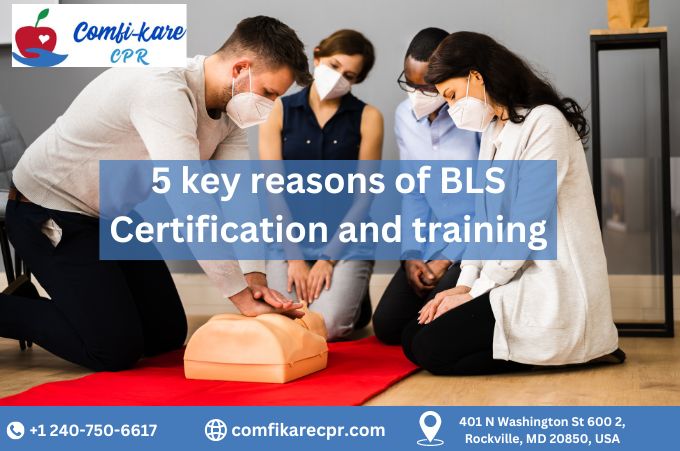
Healthcare professionals and laypersons a like must become trained in Basic Life Support (BLS) and basic life support training . BLS skills could make the difference between life and death during an emergency situation; therefore this article explores five benefits of BLS certification training and certification training for individuals in healthcare professions as well as non-medical situations.
1. The Essential Skills for Saving Lives
BLS certifications equip individuals with essential lifesaving skills. Individuals trained in BLS learn to respond appropriately in cardiac and respiratory emergencies – this includes understanding appropriate ventilation techniques as well as using an Automated External Defibrillator (AED).
Mastering CPR and Chest Compressions
CPR is an integral component of BLS. High-quality chest compressions can keep oxygen flowing to vital organs until medical help arrives; by performing CPR immediately following cardiac arrest victims have an increased survival rate; learning the correct rhythm and technique of chest compressions will allow these vital organs to continue functioning normally.
Proficiency in Airway Management and Ventilation
BLS training teaches airway management and rescue breathing techniques designed to deal with respiratory emergencies. Oxygen is key in terms of survival during respiratory distress; ventilation allows oxygen to reach our lungs quickly enough. People trained in BLS can prevent respiratory failure or suffocation by learning how to clear their airways efficiently.
2. Increased Confidence and Preparedness
BLS certification builds personal confidence and preparedness in individuals. Knowing how to respond in an emergency can reduce panic, and apprehension and enable prompt and effective actions; confidence is especially essential during high-stress situations where every second counts.
Hands-On Simulation Training
BLS courses feature simulation-based training that allows participants to practice skills under realistic scenarios. This practice builds muscle memory, reinforces correct technique, and equips individuals to respond confidently in an emergency. Through practicing in a controlled setting, participants become more acquainted with equipment and procedures used during an emergency situation.
Communication and Teamwork
BLS stresses the importance of teamwork in emergency response. Participants learn to communicate effectively, share responsibilities, and coordinate to ensure an efficient resuscitation effort. BLS-trained individuals can work as a group to cover all aspects of emergency care from calling for assistance to administering CPR or using an AED.
3. Professional Requirements and Career Advancement
BLS certification has become an essential requirement for healthcare professionals. Nurses, doctors, paramedics, and other medical personnel who rely on BLS for the safe performance of their duties often need this certification; additionally being BLS-certified opens many opportunities within healthcare fields.
Reaching Regulatory Standards
Many healthcare organizations and facilities need Basic Life Support certification to comply with regulatory standards. BLS serves as an assurance that healthcare providers will deliver high-quality care that adheres to regulations – essential in maintaining credibility and reliability among healthcare institutions.
Enhancing Employability
A BLS certification increases both employability and career opportunities for its holders. Employers place great value on this credential as it demonstrates dedication to patient safety and response in emergency situations. Furthermore, BLS can serve as the basis for more intensive training or certifications that lead to advancement within critical care, emergency medicine, or other high-stakes environments.
4. Public Safety and Community Preparedness
BLS certifications aren’t only useful to healthcare providers; they’re also invaluable tools for lay people looking to increase public security while equipping individuals with lifesaving abilities that can help communities be better prepared in case of emergency situations.
Empowering the Public Bystanders often arrive first in emergency situations. BLS training equips bystanders to take immediate action before professional help arrives – this proactive approach may save lives and improve outcomes of critical situations. BLS-trained community members can offer crucial assistance during those crucial minutes until emergency responders arrive on the scene.
Fostering Safety Culture
BLS training is widely accessible, fostering an atmosphere that places an emphasis on safety and preparedness within communities. More people trained in BLS will increase the chances of timely responses in emergency situations – creating an all-around safer environment. Certified people trained in BLS can be invaluable assets in schools, workplaces, and public places alike.
5. Enhancing Patient Outcomes and Survival Rates
BLS training and certification have as their ultimate aim improving survival rates and outcomes of cardiac arrest patients as well as other life-threatening situations. BLS can also be used to aid emergency services personnel responding to cardiac arrest cases and similar emergencies.
Early Intervention
BLS emphasizes early intervention. The sooner high-quality CPR and defibrillation are provided, the higher a person’s chance of survival and recovery becomes. BLS-trained professionals are specially trained to recognize signs of cardiac arrest quickly, thus shortening the time between events and intervention – essential in order to minimize brain damage as well as other cardiac arrest complications.
Quality of Care
BLS certification ensures individuals can provide quality emergency care during an emergency situation. CPR is performed correctly and the use of AEDs correctly is essential in maintaining circulation and preventing further degeneration; BLS can improve long-term patient outcomes and avoid complications; its providers can keep up their skills through ongoing education and certification programs.
Conclusion
BLS certification can provide many advantages to healthcare professionals as well as laypeople alike. BLS training and certification has five main benefits, which can benefit individuals as well as communities: developing essential lifesaving abilities, building confidence and readiness, meeting professional requirements and progressing your career, increasing public safety and community preparedness as well as improving patient outcomes. With BLS training and certification at their fingertips, individuals and communities can create safer environments, potentially saving lives while improving emergency outcomes in emergencies.



